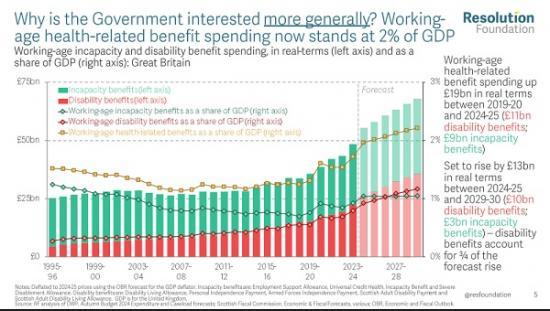Big Cuts To Welfare Benefits As Government Seeks Billions of Reductions
9th March 2025

The Government must focus on all three drivers of incapacity and disability benefit spending - entrances, entitlements and exits - if its reforms are to stem rising spending and boost living standards by getting more people back into work. This is according to new research published on Thursday by the Resolution Foundation.
Ahead of the Government's upcoming Green Paper on incapacity and disability benefits, and its more immediate need to find savings by the time of the Spring Statement on 26th March, the research examines what principles should guide the reforms.
Reform is definitely needed, with working-age benefit spending having risen sharply since the pandemic. With further real-terms increases forecast over the Parliament for these working-age benefits - £3 billion for incapacity benefits and £10 billion for disability benefits (in 2024-25 prices) - total spending is set to increase by £32 billion in real terms over a decade (2019-20 to 2029-30).
This rise partly reflects the fact that Britain is getting older and sicker - which the benefits system cannot solve. The share of working-age families with a disabled adult has increased from 22 per cent to 30 per cent over the past decade (2012-13 to 2022-23).
One possible route to stemming rising benefit spending is to restrict eligibility for support. The previous Government proposed changes to the Universal Credit Work Capability Assessment (WCA) in Autumn 2023, aiming to reduce incapacity benefit spending. However, its consultation on these changes was ruled unlawful earlier this year.
The report cautions that repeating this approach is risky as it would concentrate all the income losses on a small group of claimants.
The scale of losses faced by newly ineligible incapacity benefit claimants is due to the large gap between basic and health-related support in Universal Credit (UC). For a single adult, basic support of just £393 a month more than doubles to £810 a month if they are eligible for health-related support. This creates a strong incentive to claim the latter.
The Government should look to close this gap by redistributing levels of health-related support into basic awards. If the Government is committed to making cuts in the short term, it could reduce the gap by freezing health-related support in cash terms between 2025-26 and 2029-30, saving £1 billion a year by the end of the Parliament.
The report notes that an often-forgotten driver of rising spending, where there is ample room for improvement, is the terrible record of people moving off incapacity and disability benefits.
Incapacity benefit off-flow rates have halved since 2012, with the rate of people moving off health-related UC and into work every month standing at just 0.9 per cent. Returning off-flow rates back to their 2012 levels would save around £600 million a year.
The Foundation says that while supporting more people off health-related benefits and into work would be a ‘win-win' for fiscal savings and household incomes, delivering this will require significant investment in how the benefits system is delivered - including better-designed, more regular assessments for both health-related UC and PIP.
Louise Murphy, Senior Economist at the Resolution Foundation, said:
"Britain is getting older and sicker as a nation. The consequence is a fast-rising working-age incapacity and disability benefits bill, which is on track to rise by £32 billion a year over the 2020s.
"The benefit system can't fix these problems on its own, but a focus on the three areas that drive higher spending - entrances, entitlements and exits – could stem the increase and help more people into work.
"Rather than focus solely on restricting eligibility for support, reforms should reduce the financial gap between basic and health-related out-of-work benefits that incentivises health-related claims. Far more can be done to boost exits too, which will require investment in the functioning of the benefit system and rebuilding trust among claimants.
"While the Government is keen to score short-term welfare savings ahead of the 26th March, truly effective reforms will take time to deliver."
The Government is set to announce a Green Paper on health-related benefit reform.
£2bn health-related benefit cuts are baked into OBR forecasts and need to be specified.
The backdrop? Fast-rising spending on working-age health-related benefits; set to rise by £32bn between 2019-20 and 2029-30, from 1.3% to 2.2% of GD.
Five principles to guide policy makers through reforming incapacity and disability benefits:
Recognise that many of the drivers of rising spend sit outside of the benefits system – and so too will the solutions
Governments tend to focus on reducing health-related benefit in-flows by tightening eligibility criteria – but doing so concentrates large losses among a subset of claimants.
There should be more focus on rebalancing entitlements within the benefits system
More action is needed to improve health-related benefit off-flow rates
Ultimately, the Government should prioritise long-term improvements to the health-related benefits system over short-term cuts.
Read the full report HERE
Pdf 25 Pages
